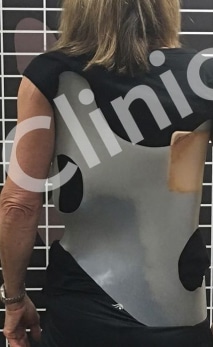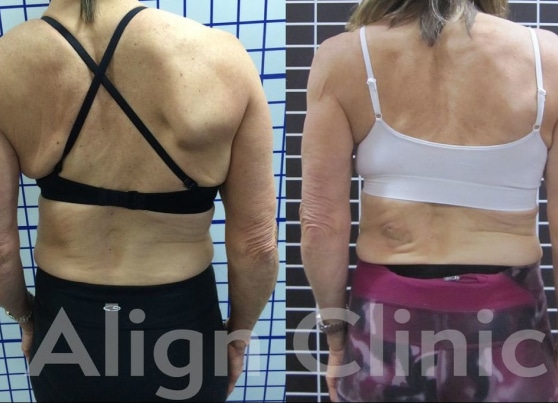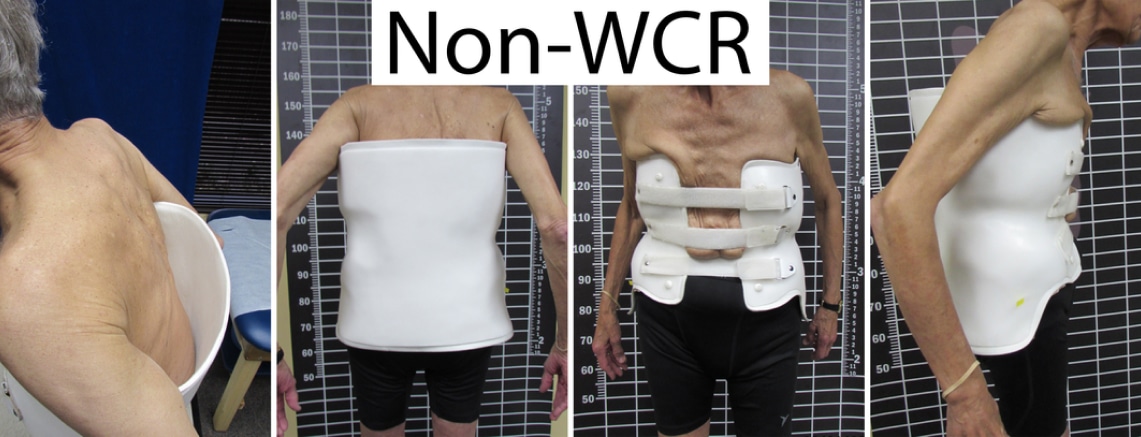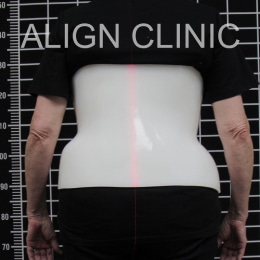Adult Scoliosis
Wood Cheneau Rigo (WCR) and Custom TLSO Braces
Treating adults with Scoliosis is a specialty that we have been doing at Align Clinic for many years. Adult bracing is really nothing like the braces used in treating growing children and it requires a special expertise and technique that we have honed over the last 15 years to be both effective and comfortable. The braces are much softer and more flexible than the braces of the “old days”. Each case is handled individually and no two cases are identical. So it doesn’t matter whether you have had untreated scoliosis all your life or whether you developed scoliosis later in life, we may be able to help. The objective of adult scoliosis bracing is to support the spine, unload deforming forces, reduce pain and slow progression of the curves. Just call to make an appointment and we will provide you with a free evaluation as to whether we can help.
WCR – A Rigo-Cheneau Style Brace
If you’d like to read more about treatments of adult scoliosis, please click the button to see Grant Wood’s publication in O&P EDGE Magazine.
Introduction
The purpose of this study is to present a description and timeline of the results achieved by applying Schroth therapy (Barcelona Scoliosis Physical Therapy School) and a modified Chêneau-type brace using Rigo principles—a Wood-Chêneau-Rigo (WCR) brace—for the conservative treatment of a 68-year-old adult female with scoliosis.
Background
This article shares the clinical presentation and brace design characteristics associated with the provision of optimal support and alignment for an adult with severe scoliosis.
Scoliosis braces of all types utilize common principles of construction that ensure good fit and function. Equally important to the result is good patient follow-up care and brace quality control by the orthotist.
Case Presentation and Methods
The patient is a 68-year-old female diagnosed with scoliosis, with right thoracic and left lumbar curves of 42 degrees and 51 degrees Cobb angles, respectively, and with thoracic and lumbar rotation of 14 degrees and 4 degrees, respectively. She also has degenerative disk disease and facet arthropathy.
Figure 1: The patient is wearing an adult WCR brace with the B1 curve pattern superimposed on the patient and brace. The three-point pressure system allows better alignment of the trunk over the pelvis. The expansion areas allow for improved breathing by providing space for the patient to move and breathe into the concave areas of the curves. This also provides a more normal physiological posture for the patient.
The patient was originally prescribed a custom TLSO, which she wore for five years, followed by use of a Spine-Cor® brace that she stated didn’t help with the pain or improve her condition. She was later prescribed a WCR adult scoliosis brace. The Chêneau-Rigo handmade brace was a B1-type model using the Rigo classification of scoliosis. However, the Rigo classification for brace design was adapted and modified specifically for an adult patient (Figure 1).
Modifications were made to make the brace more applicable and tolerable for an adult patient. Adult patients with moderate or severe scoliosis typically have significant structural changes to the spine, which are impossible to change. However, it is possible to realign and balance the posture and thereby reduce stresses to the spine. The adult WCR brace allows the patient to apply corrections to the altered scoliotic posture and to reinforce what he or she learns during Schroth therapy, which helps to minimize progression of the spinal deformity, improve body alignment, and reduce pain. It does not apply the Chêneau brace principles of overcorrection, but rather focuses on good body alignment and positioning.
Traditional TLSOs for adult scoliosis are made to accommodate the patient’s deformity. This is difficult, because the accommodative brace often doesn’t allow the patient’s body to be put into a more normal physiological position, but instead serves as a supportive device to unload forces to the spine. It props up a deformed posture, compared to the adult WCR brace’s ability to translate the trunk and pelvis, and positions the patient in his or her optimal physiological position.



Adult Patient before and after two years of bracing and diagram showing forces applied by the posture correcting Adult WCR Brace.
Conservative Treatment of Scoliosis in Adults
Scoliosis bracing for adults has been limited for decades. The most common form of treatment is an accommodative TLSO, with variations that range from a custom-made brace fabricated from a mold and/or measurements of the patient, to an off-the-shelf, prefabricated TLSO fitted to the patient.
The custom-made, accommodative TLSO usually addresses the concerns of the orthotist, physician, and patient; the type of material to be used for fabrication; and, in some cases, the amount of correction the brace should apply. The debate often centers on whether to use a soft foam with a semi-rigid interframe for patient support, or a semirigid or rigid thermoplastic brace. Addressing these factors alone is sometimes sufficient to meet the patient’s needs. However, without further customization, these braces are often less effective and are uncomfortable and bulky.
The adult WCR brace is used for adults with moderate to severe scoliosis. It is designed to reduce pain, provide alignment of the pelvis and trunk, and improve aesthetics and postural control. The adult WCR brace is fabricated from thin, semiflexible thermoplastic material; is custom made to each patient’s specific curve pattern, pressure tolerance, and autocorrection; and holds the patient in his or her optimal corrected position.
The axial loads and deforming forces to the vertebral column are supported by the adult WCR brace in a comfortable and natural way. The improved alignment of the pelvis and trunk reduces the imbalance of forces to the spine, which helps to control or slow the progression of the scoliosis by supporting it at the concavity of the thoracic spine, preventing collapse of the shoulder into the curve, aligning the lumbar spine and pelvis, and improving the patient’s balance.
WCR braces for children are different than those for adults, but both apply similar principles. The adult WCR brace has smaller pressures and expansion rooms, no clinical or radiological overcorrections, and different indications, treatment goals, and design and materials.
Adult patients who have large curve magnitudes often experience poor balance of the pelvis and trunk (decompensation of the trunk/translation of the pelvis) and significant spinal rotations—each of which is often associated with pain. In cases with significant coronal and sagittal imbalances, there may also be a poor gait pattern. Therefore, the design, function, and fitting process of a scoliosis brace must be well thought out. To accomplish this, it is recommended that a specific physical evaluation of the patient be completed, as outlined by the author in 2014.1 The result of the evaluation will guide the selection of the optimal brace type for the individual. When the WCR adult scoliosis brace is chosen, it is essential to assemble an experienced team of scoliosis professionals that includes an orthopedic surgeon, a physical therapist trained in the Schroth Method, and an orthotist.
Results and Discussion
The patient reported significant improvement in comfort and posture and a reduction in pain when compared to results of previous brace treatments.
The adult WCR brace allowed the patient to apply corrections to the altered scoliotic posture, and reinforced what she learned during Schroth therapy, which helped to minimize progression of spinal deformity, improve body alignment, and reduce pain, as well as to improve her body image and increase her activities of daily living.

Above: patient in his pre-WCR brace. Below: patient in a custom adult WCR





Patient in a custom TLSO brace (Non-WCR)

Postural corrections made by a supportive adult WCR can be seen almost immediately
References
- Wood, G. I. 2014. Bracing efficacy in the patient with idiopathic scoliosis: Improvements in technique and care coordination. The Academy Today 10 (3):A-5-8.
- Wood, G. 2015. Five-year case study of an infant with scoliosis using Schroth Therapy and Chêneau-type bracing. The O&P EDGE 14 (7):56-66.
- Wood, G. 2014. Brace modifications that can result in improved curve correction in idiopathic scoliosis. Scoliosis 9 (1). doi:10.1186/1748-7161-9-2.
- Rigo, M. D., M. Villagrasa., and D. Gallo. 2010. A specific scoliosis classification correlating with brace treatment: Description and reliability. Scoliosis 5 (1).doi:10.1186/1748-7161-5-1.
Grant Wood, MS, CPO (UK), CO (US) is the cofounder of Align Clinic, San Mateo, California, and past chair of the Spinal Orthotics Society of the American Academy of Orthotists and Prosthetists. He is a specialist in scoliosis bracing with the Chêneau brace and the WCR brace.
Acknowledgement: The author would like to thank Manuel Rigo, MD, of E. Salvá Spinal Deformities Rehabilitation Institute of Barcelona, Spain, for Rigo Classification of Scoliosis and brace design training. Academy Society Spotlight is a presentation of clinical content by the Societies of the American Academy of Orthotists and Prosthetists in partnership with The O&P EDGE.


